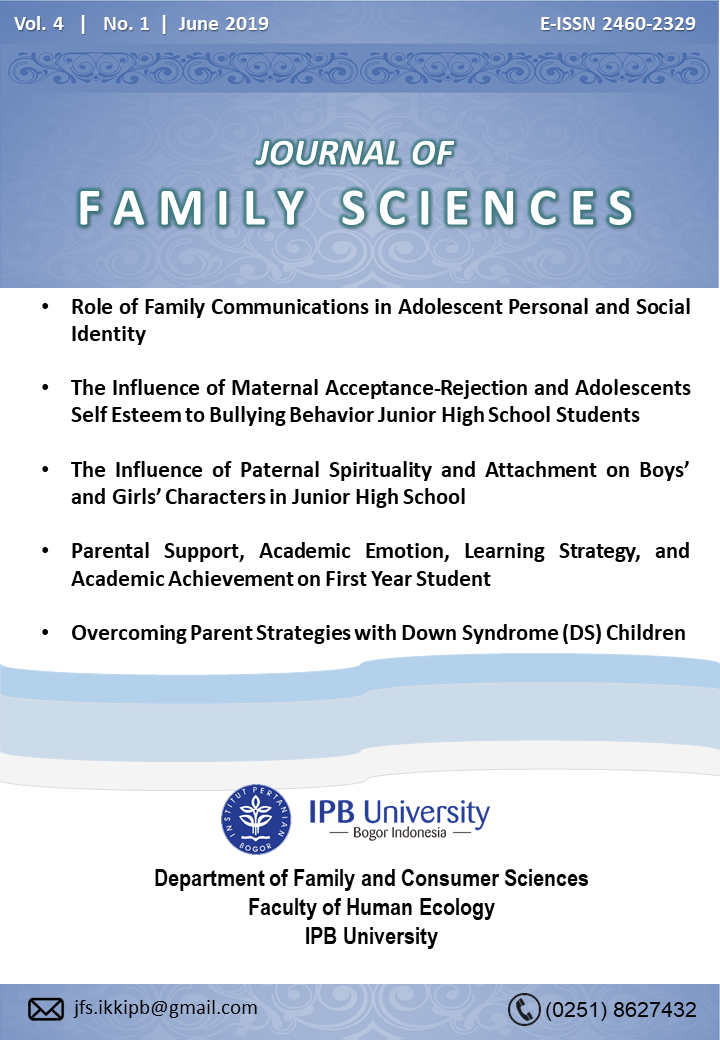The Influence of Maternal Acceptance-Rejection and Adolescents Self Esteem to Bullying Behavior Junior High School Students
Abstract
This study aimed to analyze the influence of maternal acceptance-rejection and self-esteem adolescents on bullying behavior of junior high school students. The study took place at two junior high schools located in Bogor City and involved 86 students who were selected using simple random sampling. The measuring instrument used in this study was a PAR adaptation from Rohner (1986) with a reliability of 0.785, self-esteem instrument adaptation from Rosenberg's (1965) with a reliability of 0.773, and a bullying behavior instrument adaptation from Hastuti, Herien, and Djaswelma (2015) with the reliability of 0.902. Data analysis used in this study was descriptive statistical analyses and statistical analyses of Pearson correlation and linear regression tests. The data were collected using self-administered questionnaires guided by the researcher. The results showed that more than half of adolescents had perceptions of affective parenting. However, about 40 percent of adolescents have self-esteem in the low category. The most common type of bullying behavior adolescents is verbal bullying. The test results showed that parents with aggression and undifferentiated rejection are unfortunately related to the adolescents’ bullying, and low adolescents’ self-esteem is followed by bullying behavior. Gender (male adolescents) and low self-esteem had a significant effect on bullying behavior. Meanwhile, parental rejection had a significant positive effect on bullying behavior.
Downloads
References
Anwas, O.M. (2010). Televisi mendidik karakter bangsa: Harapan dan tantangan. Jurnal Pendidikan dan Kebudayaan. 16(3), 256-266.
Arifinda, N.A. (2015). Pengaruh akses media televisi dan peniruan muatan kekerasan terhadap perilaku bullying siswa sekolah dasar [skripsi]. Bogor (ID): Sekolah Pascasarjana IPB.
Aslan, S. (2011). The analysis of the relationship between school bullying perceived parenting styles and self-esteem in adolescents. Journal Procedia - Social and Behavioral Sciences. 30, 1798-1800.
Atik, G., Gurneri, O.Y. (2013). Bullying and victimization: Predictive role of individual, parental, and academic factors. School Psychology International. 34(6): 658-673.
Bandura, A. (1965). Influence of models’ reinforcement contingencies on the acquisition of imitative responses. Journal of Personality and Social Psychology. 1(6).
[BKKBN]. Badan Koordinasi Keluarga Berencana Nasional. 1998. Data Besar Keluarga [internet]. [Diunduh pada 2018 February 2]. Tersedia pada http://bkkbn.go.id
Carlerby, H., Viitasara, E., Knuttson, A., Gadin, K.G. (2013). How bullying involvement is associated with the distribution of parental background and with subjective health complaints among Swedish boys and girls. Social Indicators Research. 111(3): 775-783.
Cook, C.R., Williams, K.R., Guerra, N. (2010). Predictors of bullying and victimization in childhood and adolescence: A meta-analytic investigation. School Psychology Quarterly. 25, 65–83.
Coopersmith, S. (1967). The Antecedents of Self-Esteem. San Francisco: W.H. Freeman.
Cournoyer, D.E., Sethi, R., Cordero, A. (2005). Perceptions of parental acceptance rejection and self concept among university students. Pro Quest Sociology. 33 (3), 335
Djaswelma. (2015). Gaya pengasuhan ibu dan perilaku bullying remaja pada keluarga bercerai di kota bogor. [tesis]. Bogor (ID): Sekolah Pascasarjana IPB.
Due, P & Holstein, B.E. (2008). Bullying victimization among 13 to 15-year-old school children: results from two comparative studies in 66 countries and regions. International Journal Adolescent Medical Health. 20(2): 209-222.
Eskisu, M. (2014). The relationship between Bullying, family functions and perceived social support among high school students. Journal Procedia Social and Behavioral Sciences. 159, 492-496.
Fitria., Auli, R. (2016). Faktor-faktor yang berhubungan dengan perilaku bullying. Idea Nursing Journal. 7(8), 9-17.
Guindon, M.H. (2009). What is Self-esteem? Di dalam: Guindon MH, editor. Self-esteem Across the Lifespan. New York: Rotledge,3-24.
Hastuti, D., Agung, S.S., Alfiasari. (2013). Kajian karakteristik remaja desa-kota, sekolah, serta keluarga untuk mengatasi perilaku antisosial remaja SMK di Kota dan Kabupaten Bogor. Prosiding Seminar Hasil-Hasil PPM IPB II, hlm 653-667.
Karina. (2012). Perilaku bullying dan karakter remaja serta kaitannya dengan karakteristik keluarga dan peer group. Jurnal Ilmu Keluarga dan Konsumen. 6(1), 20-29.
[KPAI] Komisi Perlindungan Anak Indonesia. (2016). Kasus Pengaduan Anak Berdasarkan Klaster Perlindungan Anak. Diambil dari: http://kpai.go.id/berita/kpai-kasus-pengaduan-anak-berdasarkan-klaster-perlindungan-anak/.
Ogelman, H.G., (2015). Predictor effect of parental acceptance-rejection levels on the resilience of preschool children. Journal Prosedia-Social and Behavioral Sciences. 174, 622-628.
Olweus, D. (2003). Bullying at School: Long Term Outcomes for The Victims And An Effective School-Based Intervention Programs. In: L.R Huesmann (Ed) Aggressive Behavior: Currents perspectives. New York. Plenum Pers.
Owens, L. (2005). Sex and age differences in victimization and conflict resolution among adolescents in a South Australian school. Aggressive Behaviour. 31(1).
Patchin, J.W., Hinduja, S. (2010). Cyberbullying and self-esteem. Journal of School Health. 80(2): 614-621.
Piskin, M. (2010). Examination of peer bullying among primary and middle school children in Ankara. Egitim ve Bilim. 35(156): 175-189.
Rahayu, N.D. (2017). Pengaruh pengasuhan penerimaan penolakan dan kelekatan ibu-anak terhadap karakter disiplin anak usia prasekolah [skripsi]. Bogor (ID): Institut Pertanian Bogor.
Riska, H.A., Krisnatuti, D. (2016). Self esteem remaja perempuan dan kaitannya dengan pengasuhan penerimaan-penolakan ibu dan interaksi saudara kandung. Jurnal Ilmu Keluarga dan Konsumen. 10(1): 24-35.
Rohner, R.P. (1986). The Warmth Dimension Of Parenting: The Parental Acception Rejection Theory. Beverly Hills, California, US: Sage Publication Santrock, J. W. (2003). Adolescence: ed keenam. Jakarta (ID): Erlangga.
Rosenberg, M. (1965). Society and The Adolescent Self-Image. Princeton, NJ: Princeton University Press.
[Sejiwa] Semai Jiwa Amini. (2008). Penelitian Menganai Kekerasan di Sekolah.
Triantoro, S. (2015). Are daily spiritual experiences, self-esteem, and family harmony predictors of cyberbullying among high school student?. International Journal of Research Studies in Psychology. 4(3): 23-33.
Tsaousis, I. (2016). The relationship of self-esteem to bullying perpetration and peer victimization among schoolchildren and adolescents: A meta-analytic review. Aggression and Violent Behavior.
UNESCO. (2017). School Violence and Bullying: Global Status Report. Presented at the International Symposium on School Violence and Bullying: From Evidence to Action, Seoul, Republic of Korea, 17 – 19 January 2017.
UNICEF. (2016). Special Representative of the Secretary-General on Violence against Children. Ending the torment: Tackling bullying from the schoolyard to cyberspace.
Voluntir, F. (2014). Pengasuhan penerimaan-penolakan dan lingkungan pengasuhan pada kelarga dengan anak remaja di area suburban [skripsi]. Bogor (ID): Institut Pertanian Bogor.
Wang, H., Zou, X., Lu, C., Wu, J., Deng, X., Hong, L., Gao, X., He, Y. (2012). Adolescent bullying involvement and psychosocial aspects of family and school life: a cross-sectional study from Guangdong province in China. Journal Plos One. 7(7), 1-10.
Wright, M.F. (2016). The roles of bullying involvement and parental warmth in non-suicidal self-harm and suicidal ideation among adolescents from a residential program. Journal of criminal psychology. 6(4): 202-213.
Authors who publish with this journal agree to the following terms:
- Authors retain copyright and grant the journal right of first publication with the work simultaneously licensed under

This work is licensed under a Creative Commons Attribution 4.0 International License. that allows others to share the work with an acknowledgement of the work's authorship and initial publication in this journal. - Authors are able to enter into separate, additional contractual arrangements for the non-exclusive distribution of the journal's published version of the work (e.g., post it to an institutional repository or publish it in a book), with an acknowledgement of its initial publication in this journal.
- Authors are permitted and encouraged to post their work online (e.g., in institutional repositories or on their website) prior to and during the submission process, as it can lead to productive exchanges, as well as earlier and greater citation of published work (See The Effect of Open Access).



_001.png)



